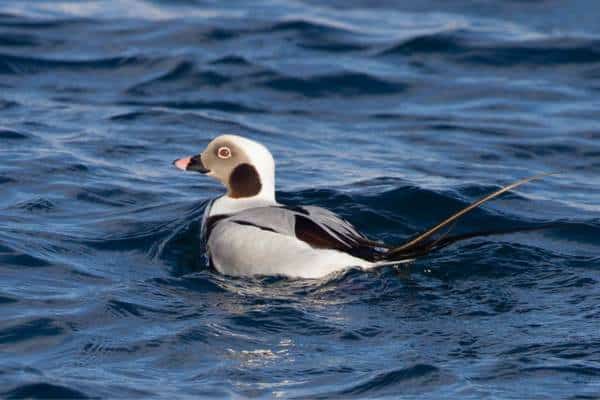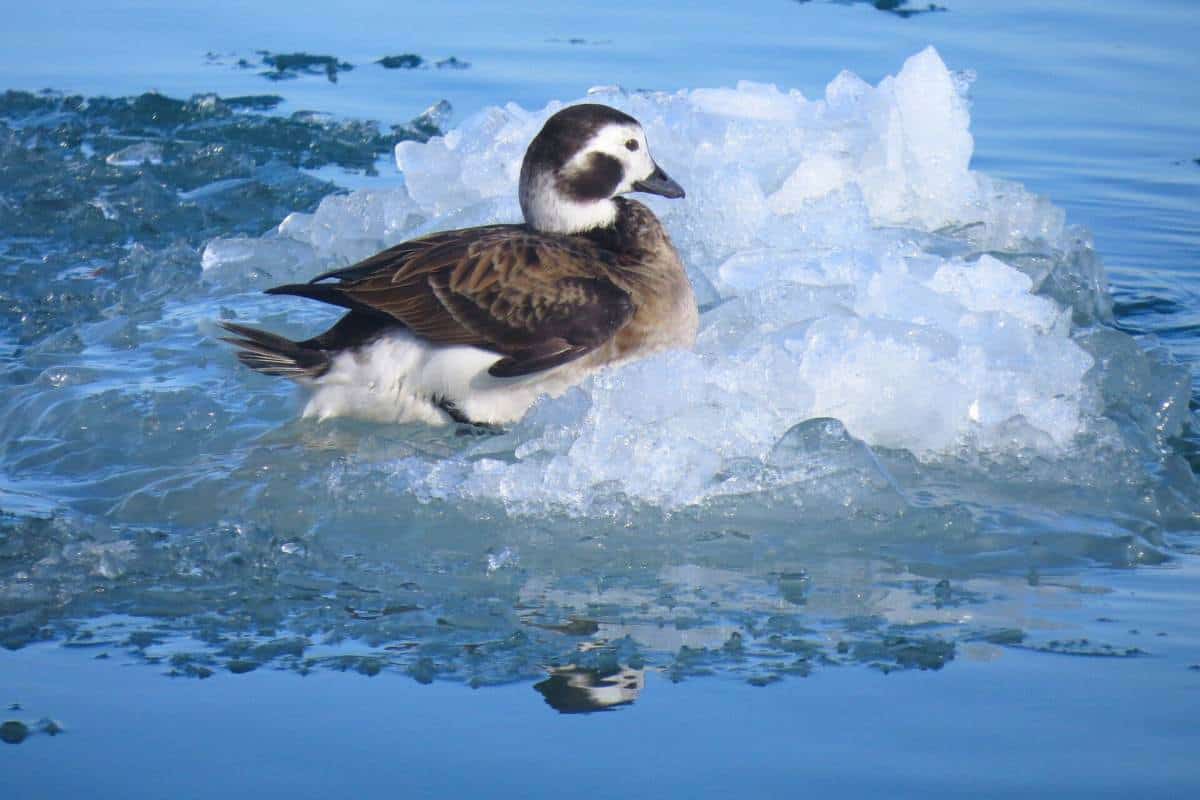Common Name: Long-tailed Duck
Scientific Name: Clangula hyemalis| Size | Diet | Range in Hawaii | Status in Hawaii |
|---|---|---|---|
| 15 in. - 20 in. | mollusks, crustaceans, and small fish | Unknown | Vulnerable |
The Long-tailed Duck, also known as Clangula hyemalis, is a species that embodies both beauty and resilience. Its distinct features, combined with its extraordinary journey across vast distances, have made it a true marvel of the avian kingdom. While the bird’s primary habitats are often associated with northern regions, there is an intriguing twist to its tale—an unexpected presence in the tropical paradise of Hawaii.
In the remote and serene waters of the Hawaiian Islands, far from the icy realms that are typically home to the Long-tailed Duck, a handful of individuals have chosen to defy convention. These wayward wanderers bring an unexpected touch of Arctic charm to the tropical archipelago, captivating both locals and visitors fortunate enough to spot them amidst the crystal-clear waves. While sightings of the Long-tailed Duck in Hawaii are relatively rare, their presence serves as a testament to the bird’s remarkable adaptability.
Long-tailed duck
Appearance

The Long-tailed Duck, with its unique and captivating appearance, is truly a sight to behold. This medium-sized sea duck stands out from its counterparts with a striking elegance that sets it apart.
Measuring approximately 15 to 20 inches in length, the Long-tailed Duck possesses a slender and streamlined body shape, perfectly adapted for its life on the water. Its plumage undergoes a remarkable transformation, showcasing a stunning contrast between its breeding and non-breeding seasons.
Adding to its charm, the male Long-tailed Duck boasts long, slender tail feathers, extending well beyond its body, giving rise to its evocative name. The female Long-tailed Duck, on the other hand, possesses a more subdued yet equally elegant appearance.
Diet
This sea-faring bird has adapted to thrive in cold northern waters, and its diet reflects its resourcefulness and resilience. Feeding primarily on marine invertebrates, the Long-tailed Duck has a diverse and varied menu. Its preferred delicacies include a range of aquatic creatures such as mollusks, crustaceans, and small fish.
Nesting
Nesting primarily on the ground, the Long-tailed Duck seeks out remote, undisturbed areas in coastal tundra or Arctic islands for its breeding purposes. Here, amidst the windswept landscapes, the female constructs a well-hidden nest, often nestled among grasses, mosses, or low vegetation.
Using a combination of her own down feathers and available plant materials, the female crafts a shallow depression that provides a cozy and protected space for her eggs. The nest’s lining not only insulates the eggs but also helps camouflage them from potential predators.
Once the nest is complete, the female Long-tailed Duck lays a clutch of 5 to 9 eggs, which are typically light olive or greenish in color. The eggs are carefully incubated by the female, who diligently tends to them, rotating and rearranging them for optimal warmth and protection.
During the incubation period, which lasts around 25 to 28 days, the male Long-tailed Duck keeps a watchful eye nearby, ensuring the safety of the nesting female and their future offspring. His role is critical, as he stands guard against potential threats and intruders that may venture too close to the nest.
Once the eggs hatch, the Long-tailed Duck chicks, known as ducklings, emerge into the world. These adorable bundles of fluff are precocial, meaning they are relatively independent and able to move and feed themselves shortly after hatching. Guided by their instincts, they quickly follow their parents to the nearest water source, where they begin to learn the art of foraging and navigating their aquatic environment.
Behavior

One of the most notable behaviors of the Long-tailed Duck is its remarkable diving prowess. Equipped with specialized adaptations, including dense feathers and a streamlined body, this bird can plunge into the water with agility and grace. It can remain submerged for astonishing periods, reaching depths of up to 200 feet in its search for food. Resurfacing with a triumphant leap, the Long-tailed Duck showcases its exceptional skills as an underwater hunter.
During the breeding season, the Long-tailed Duck engages in captivating courtship rituals. Males participate in elaborate displays to attract the attention of females. These displays often involve energetic swimming, head bobbing, and wing flapping, accompanied by a melodious vocalization. Through these enchanting performances, the males aim to impress the females and establish their prowess as potential mates.
Socially, Long-tailed Ducks typically form small to large flocks during the non-breeding season, often congregating in coastal areas or open waters. These flocks can be seen engaging in synchronized swimming patterns, creating a mesmerizing spectacle of harmony and coordination.
The Long-tailed Duck’s behavior is not confined to its interactions with its own species. It often shares its habitat with other sea ducks and seabirds, displaying both tolerance and occasional aggression, especially during the breeding season when competition for resources and mates is heightened.
In terms of migration, the Long-tailed Duck embarks on remarkable journeys that span thousands of miles. From its breeding grounds in the Arctic and subarctic regions, it migrates southward to coastal areas, lakes, and even unexpected locations like Hawaii. This avian wanderer’s migratory behavior showcases its ability to navigate vast distances and adapt to diverse habitats.
Habitat

The Long-tailed Duck thrives in a variety of habitats, but its primary nesting grounds are the remote and undisturbed coastal tundra or Arctic islands. During the non-breeding season, it can be found in coastal areas, estuaries, and bays, including the unexpected presence in Hawaii, where it adds a touch of Arctic charm to the tropical paradise.
Range
The Long-tailed Duck has been sporadically observed in coastal areas and open waters of the Hawaiian Islands, making its range in Hawaii relatively limited and occasional. These sightings add an unexpected touch of Arctic charm to the tropical paradise, highlighting the bird’s ability to venture beyond its typical habitat and explore new territories.
Conservation Status
The Long-tailed Duck (Clangula hyemalis) holds a vulnerable status on the IUCN Red List of Threatened Species, signaling the need for conservation efforts. This captivating bird faces various challenges throughout its range, including habitat degradation, climate change impacts, pollution, and disturbance.
Interesting Facts
1. Population fluctuations
The population of Long-tailed Ducks can undergo significant fluctuations from year to year. Factors such as food availability, reproductive success, and environmental conditions can impact their numbers, leading to variations in population size.
2. Feather maintenance
Long-tailed Ducks engage in preening, a behavior that involves meticulously cleaning and maintaining their feathers. Preening helps to waterproof their plumage, ensures proper insulation, and keeps their feathers in optimal condition for flying and diving.
3. Adaptability to brackish water
While Long-tailed Ducks are primarily found in marine environments, they can also adapt to brackish water habitats such as estuaries and coastal lagoons. This adaptability allows them to exploit a wider range of foraging opportunities.
4. Wing whirring display
During territorial disputes or courtship interactions, Long-tailed Ducks may perform a unique behavior known as “wing whirring.” This involves rapidly beating their wings while hovering just above the water’s surface, creating a distinctive buzzing sound.
5. “Tidal wave” feeding strategy
Long-tailed Ducks employ a unique feeding technique known as the “tidal wave.” They swim in a coordinated line, flapping their wings and creating underwater turbulence that stirs up small prey items, making it easier for them to capture and consume their food.
Frequently Asked Questions
How long can Long-tailed Ducks stay underwater?
Long-tailed Ducks have impressive diving capabilities and can stay submerged for over a minute. They can dive to depths of up to 200 feet (61 meters) in search of food.
How long do Long-tailed Ducks live?
Long-tailed Ducks have relatively long lifespans for waterfowl. They can live up to 20 years or more, contributing to their ability to undertake multiple breeding seasons.
Why are Long-tailed Ducks called “Long-tailed”?
Long-tailed Ducks derive their name from the elongated central tail feathers that the males possess during the breeding season. These tail feathers extend beyond the rest of their plumage, giving them a distinct and noticeable long-tailed appearance.
How fast can Long-tailed Ducks fly?
Long-tailed Ducks are agile and swift flyers. They can reach speeds of up to 70 miles per hour (112 kilometers per hour) during migration, enabling them to cover considerable distances efficiently.
Can Long-tailed Ducks interbreed with other duck species?
Long-tailed Ducks generally do not interbreed with other duck species. They have distinct behaviors, breeding habitats, and genetic characteristics that keep them reproductively isolated. Hybridization with other duck species is rare, although there have been a few documented cases of hybrid individuals.




